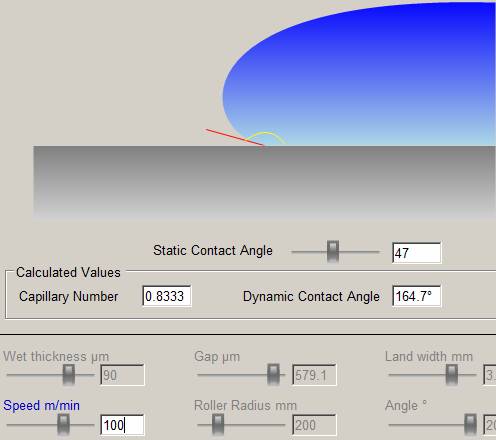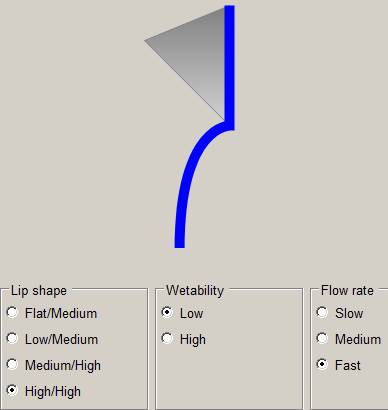Wetting Modellers
The Wetting part of TopCoat covers a large range of phenomenon.
![]()
Here are just two examples, one for experts, one for everyone.
We are all familiar with the notion of contact angle and we can easily measure it with a goniometer. (But in case a user isn't familiar, TopCoat explains it all). In a real coating situation, the static contact angle is no longer relevant and it's the dynamic contact angle which is important. When this gets very high, problems such as air entrainment arise.
As it happens, there is not a perfect formula for calculating dynamic contact angle. However, the Shikhmurzaev approach is recognised as being the most powerful and is the one used in TopCoat. It is complex to calculate, but fortunately all you need are the results:

In this example at 10m/min the dynamic contact angle is 106º for a liquid which has a static angle of 47º. As you go to 100 m/min the angle is getting dangerously high - you can imagine how easily the system could entrain air:

On an apparently lighter note, the annoying phenomenon of the Teapot Effect is discussed. Whilst this is mild annoyance when you are pouring tea, it can be a serious safety hazard when pouring chemicals. It is not possible to include accurate calculations of the effect in TopCoat as it is such a complex phenomenon, even now not fully understood. But the illustrations capture the essence of the phenomenon rather well. You quickly find that pouring something with a poorly designed lip:

is not such a good idea. Instead you need to be smarter:

There's an important and surprising sting in the tail. If we use the same setup as above, but pour slowly we find:

Things are even better. But as slow is generally bad in a production environment, let's go for Medium:

Amazingly, Medium is the worst possible case. This accords with our tea-time experience. We never have the courage to pour quickly, it's difficult to get a slow flow, so we end up making the biggest mess of all by pouring at the medium speed.
Finally, here's the advice from TopCoat itself. The trick with the dab of butter (or low-cholesterol spread) is particularly recommended):

